I have been dreaming to go to Oaxaca Mexico for the Dia De Muertos, for years… no exaggeration, really for years.
Then pandemic happened, life happened and it kept postponing until early 2023, when I recently came back from my trip in South East Asia:
It was a trip that not only broadened my horizons but also crystallised a decision: no more excuses, no more delays. This was the year I would finally immerse myself in the profound magic of Dia De Muertos in Oaxaca.
If you’re contemplating diving into one of Mexico’s most vivid, profound, and thought-provoking experiences, you’re in the right spot. I am going to explain what is Dia De Muertos and how you can make the most out of it!
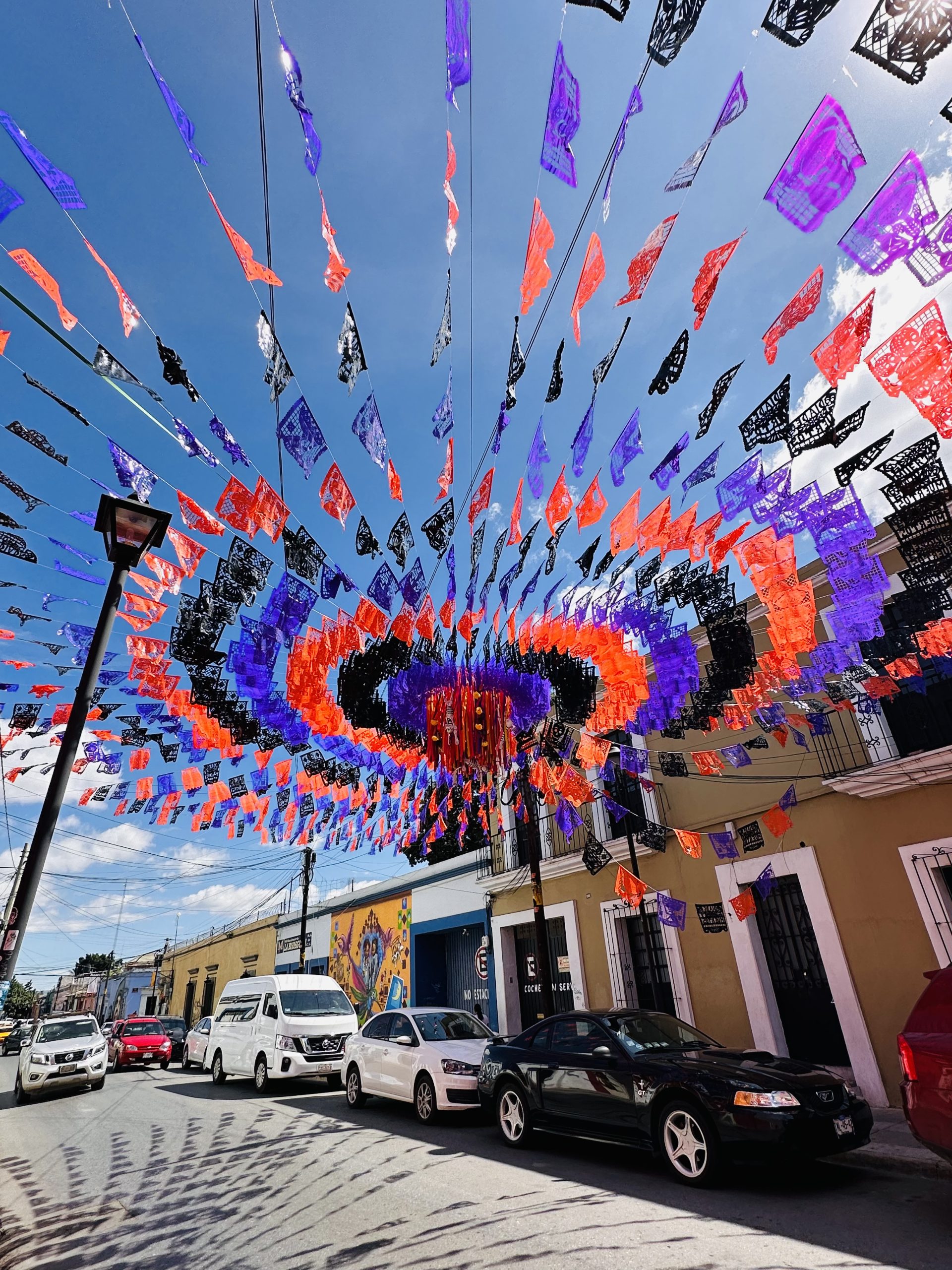
What is Dia De Muertos?
Día de los Muertos, known as the Day of the Dead in English and fondly called “Muertos” in Oaxaca, is a special holiday celebrated on November 2nd in Mexico. During this time, families create special altars with pretty flowers, a traditional drink called Mezcal, and lots of delicious food. All of this is done to show love and respect for their deceased loved ones.
To make things even more lively, there are parades called comparsas that bring excitement to the celebration. The most colorful parades happen in the neighborhoods, or colonias, outside the main city.
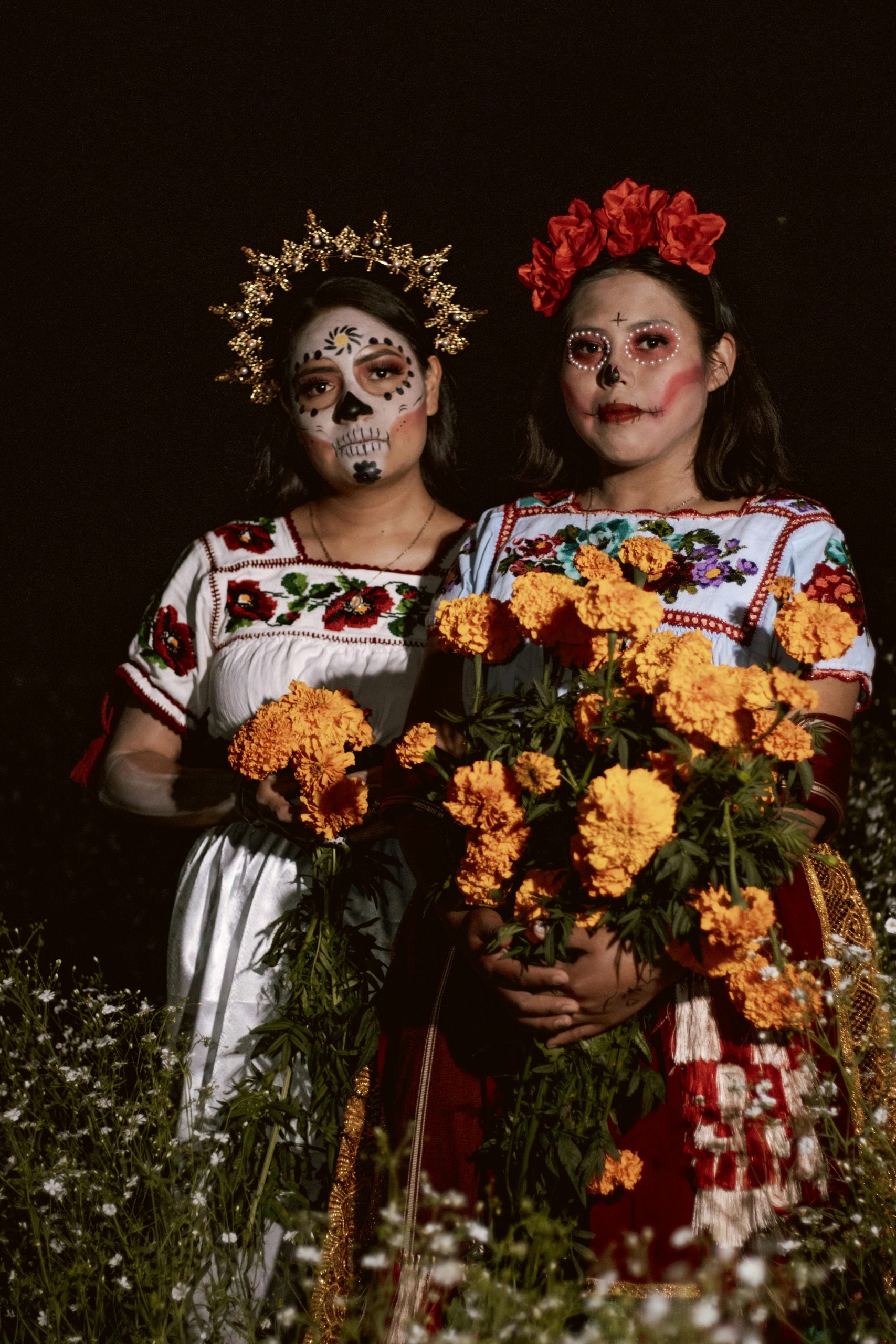
While the Day of the Dead has deep roots in both ancient and modern Mexican culture, its influence reaches beyond borders. Mexican people living abroad and those who follow the Catholic faith in Latin America also take part in the celebration, adding their own special touch to the tradition.
Over the years, Mexican families have created their own unique ways of celebrating. Some decorate the graves of their loved ones with the same care and attention as the altars in their homes. Interestingly, the actual day of the holiday is usually calm in Oaxaca. On November 2nd, families prefer quiet moments at home, leading the city to gracefully close down. Most events and celebrations linked to the holiday happen in the two weeks before November 2nd, building up to the lively Muertos season that has practically become synonymous with the vibrant spirit of Oaxaca.
The roots of the Day of the Dead are wrapped in mystery, forming a rich story woven from a mix of Catholic and Mesoamerican pagan beliefs dating back to pre-Hispanic times. In those ancient times, indigenous communities crafted figures shaped like humans from amaranth dough, adorned with prickly pear juice. These figures represented the flow of blood and served as poignant symbols for those who had journeyed into “Mictlan,” the Aztec underworld.
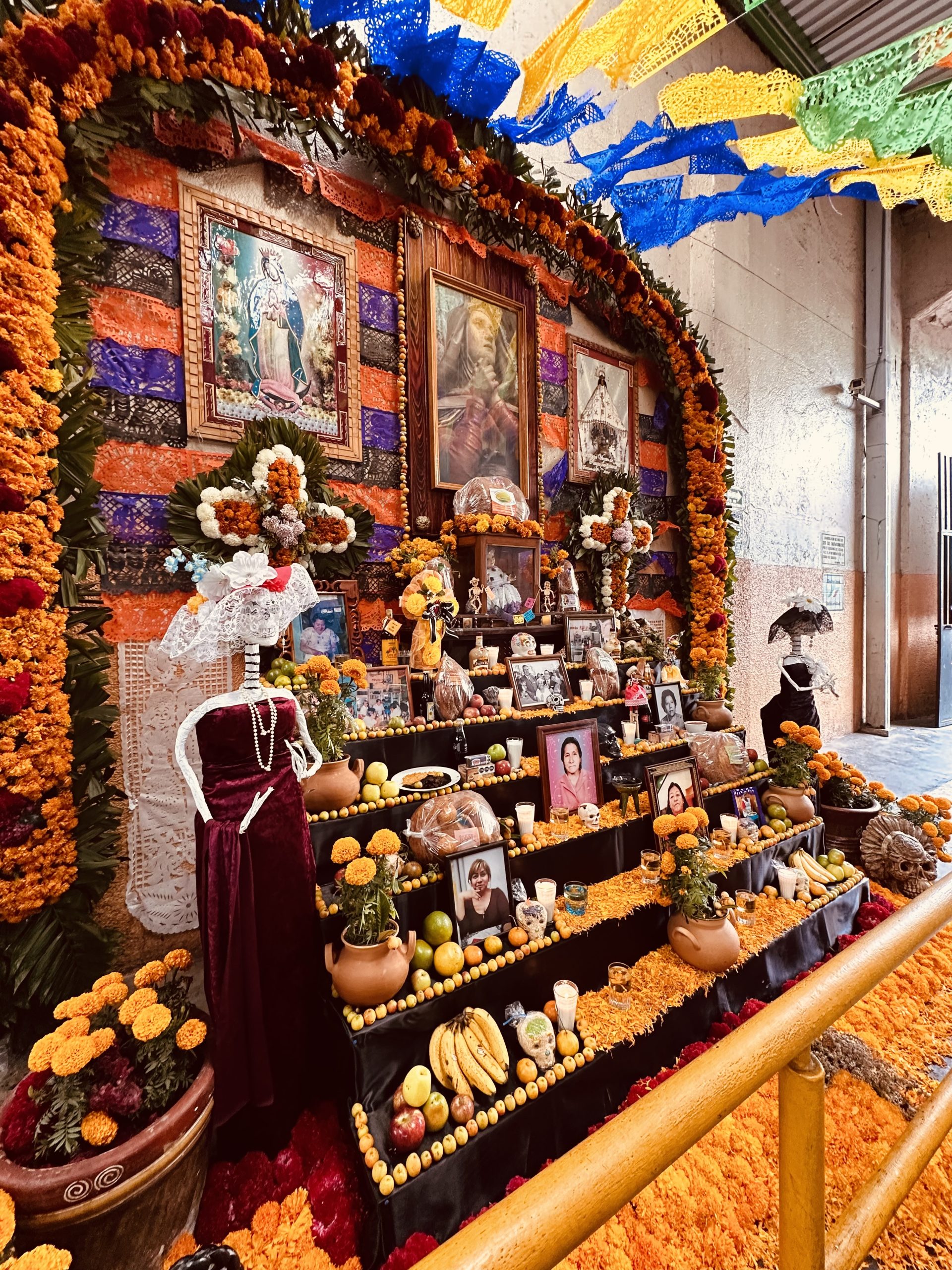
The story takes a twist during the colonization of Mexico when the Conquistadores encountered the native peoples’ ancient blood rituals in Tenochtitlán, the once-grand capital of the Aztec empire (now Mexico City). Intrigued by these pagan practices, the Conquistadores aimed to blend them with Catholicism. They strategically aligned this pagan festival, initially celebrated in the summer, with the Catholic holidays of All Saints Day and All Souls Day at the beginning of November. This way, a blended celebration emerged, weaving together the indigenous respect for the departed with Catholic traditions, giving birth to the lively and culturally rich observance we now call the Day of the Dead.
Celebrating Dia De Muertos:
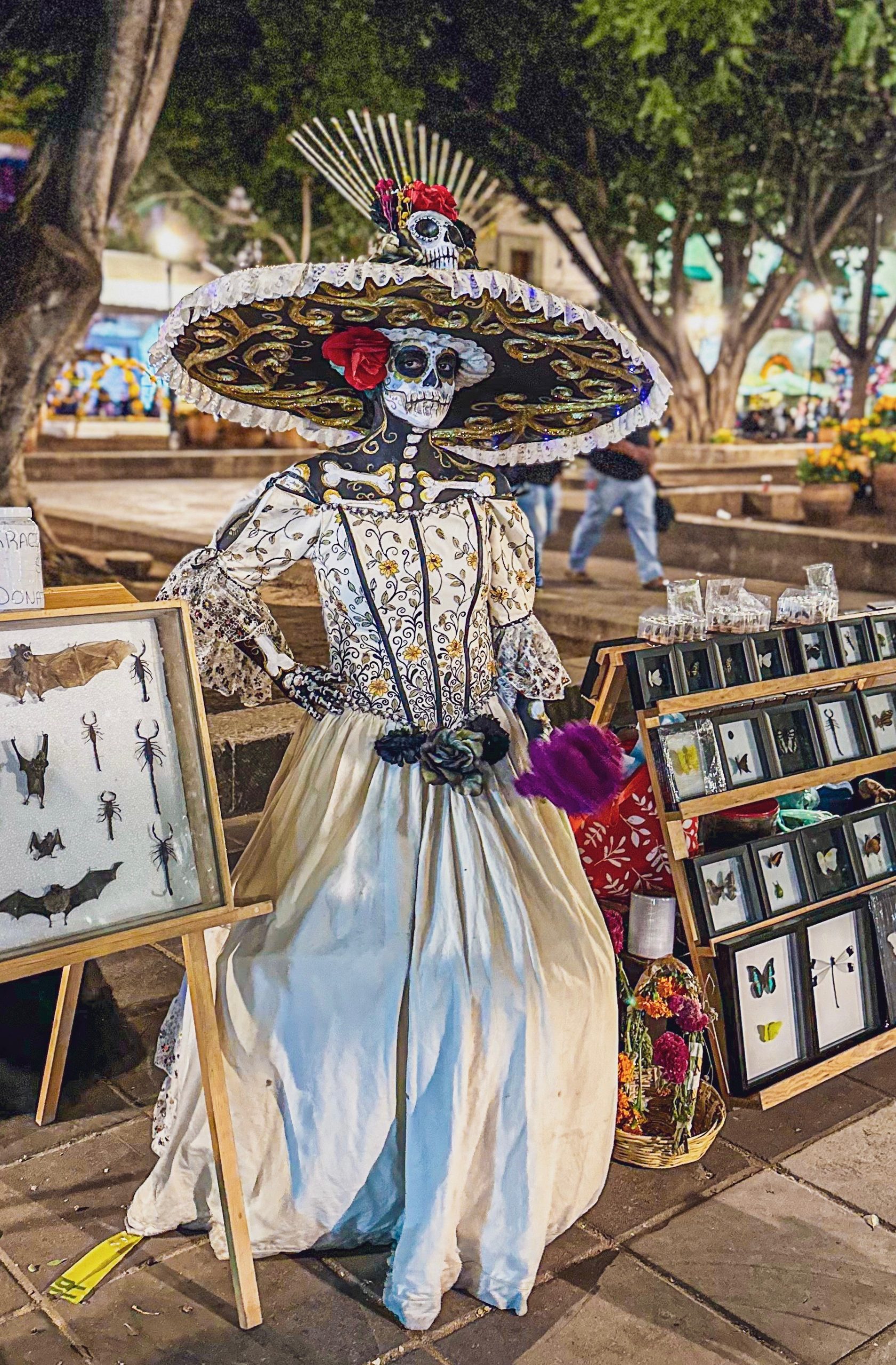
In 2008, UNESCO acknowledged Mexico’s Indigenous Feast Dedicated to the Dead as an Intangible Cultural Heritage of Humanity.
Celebrating Día de los Muertos is a deeply personal experience, and each state, city, and region in Mexico brings its own customs and traditions to the observance. As a result, there’s no one-size-fits-all way to celebrate the holiday. However, certain elements are essential to the celebration, such as creating an altar (the ofrenda), having pan de muerto (a special bread), using cempasuchil (marigold flowers), applying traditional skull face makeup, and enjoying calaveritas (skull-shaped candies).
The diversity in celebrations reflects the deeply rooted belief that Día de los Muertos transcends any singular definition. Personal beliefs, geographical locations, and religious affiliations all influence how individuals and families choose to observe this tradition. While tourists may be familiar with the public parades known as comparsas and the display of public altars in major cities during the Day of the Dead season, locals who follow a more traditional approach adhere to customs rooted in the old ways of the Catholic faith.
According to these beliefs, the time between All Hollow’s Eve and All Souls Day is significant. It is thought that during this period, the veil separating our world from the netherworld is thinnest, allowing the souls of the deceased to freely move between realms. Families gather in their homes to create personal altars adorned with photographs, candles, marigold flowers, and cherished belongings of their departed loved ones. Through prayers, memories, and offerings of food and drink, they honor and remember those who have passed away. It becomes a time of reflection, celebration, and a deep connection with the spirits of deceased family members.
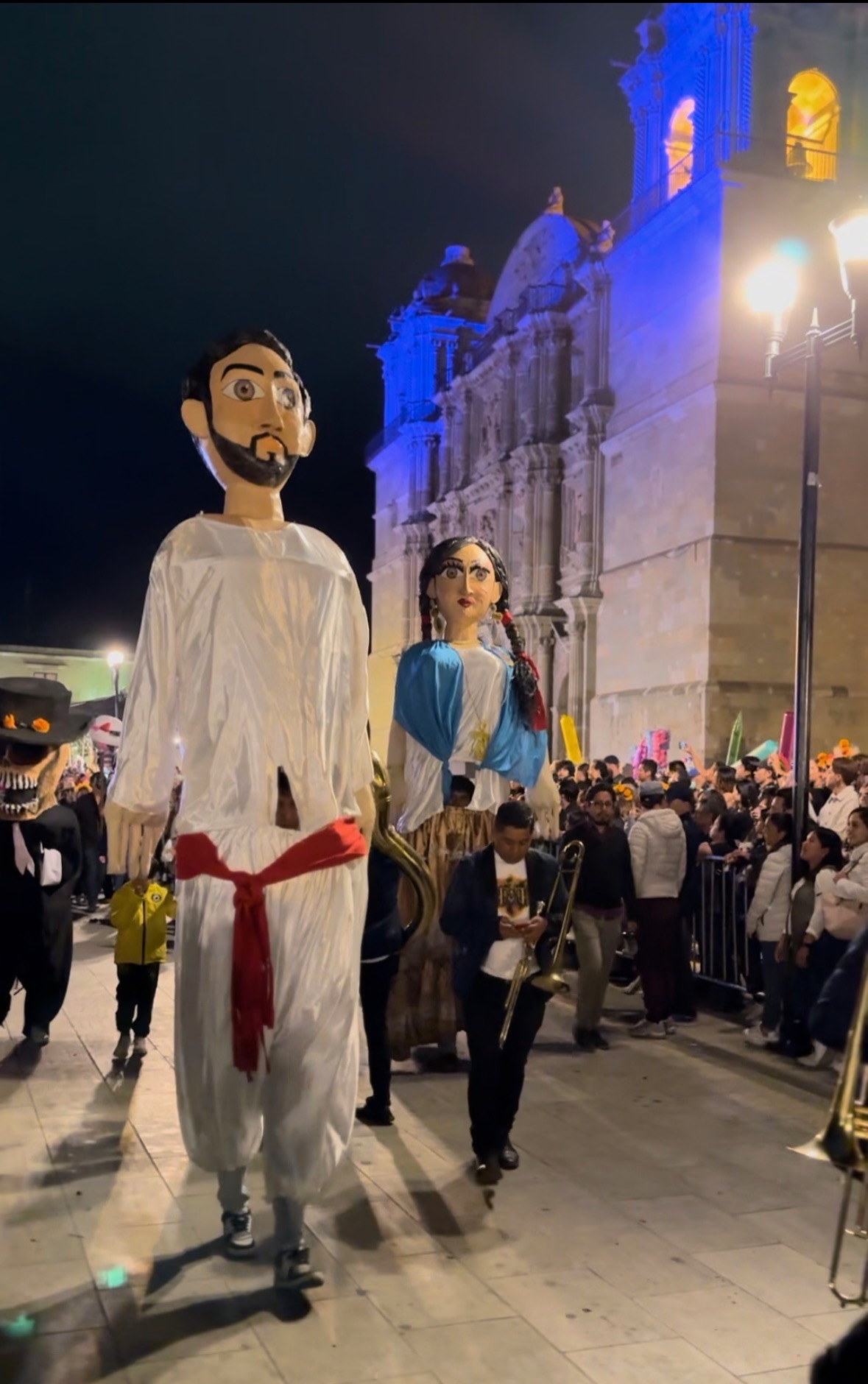
Experiencing Dia De Muertos As First Timers:
For those new to Oaxaca during the Day of the Dead, I highly recommend starting your exploration in the heart of the historic center. Here, the lively energy of Comparsas (between the night of November 1st and November 2nd), traditional parades, effortlessly becomes a common spectacle throughout the season. A casual evening stroll out of your hotel is likely to lead you to one of these captivating processions. Additionally, the historic center is adorned with numerous public Día de los Muertos altars showcased in businesses and art galleries, all within easy reach.
Save the off-the-beaten-path adventures for later visits when you’ve become more familiar with the local customs and diverse neighborhoods.
Alternatively, you could opt for a tour with a company. Personally, I didn’t choose this option. All the tours tend to be quite expensive (typically around 100+ euros per person), so it’s up to you to decide if you’re willing to pay that much for an experience that you can easily enjoy on your own.
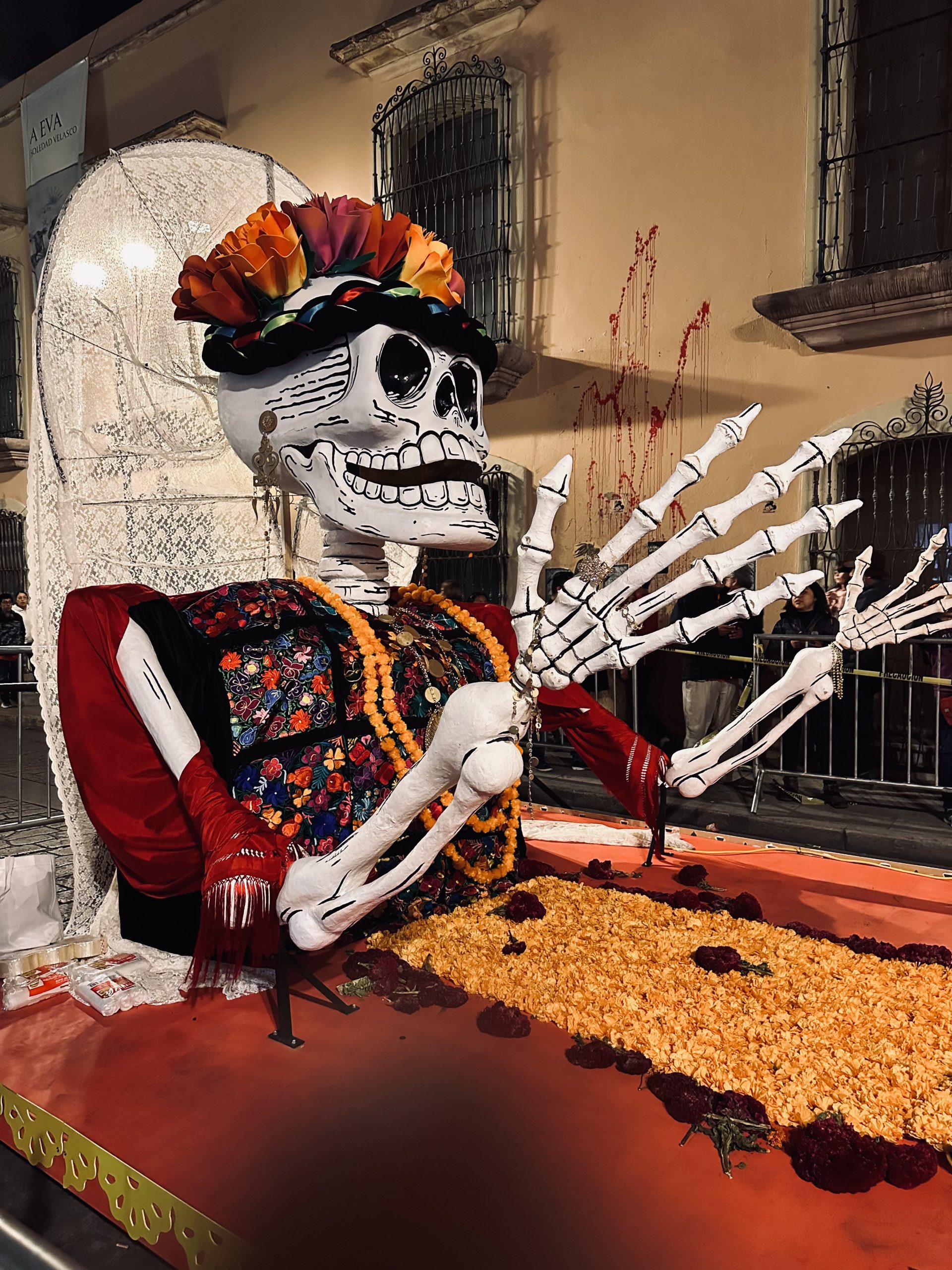
Visiting The Cemeteries:
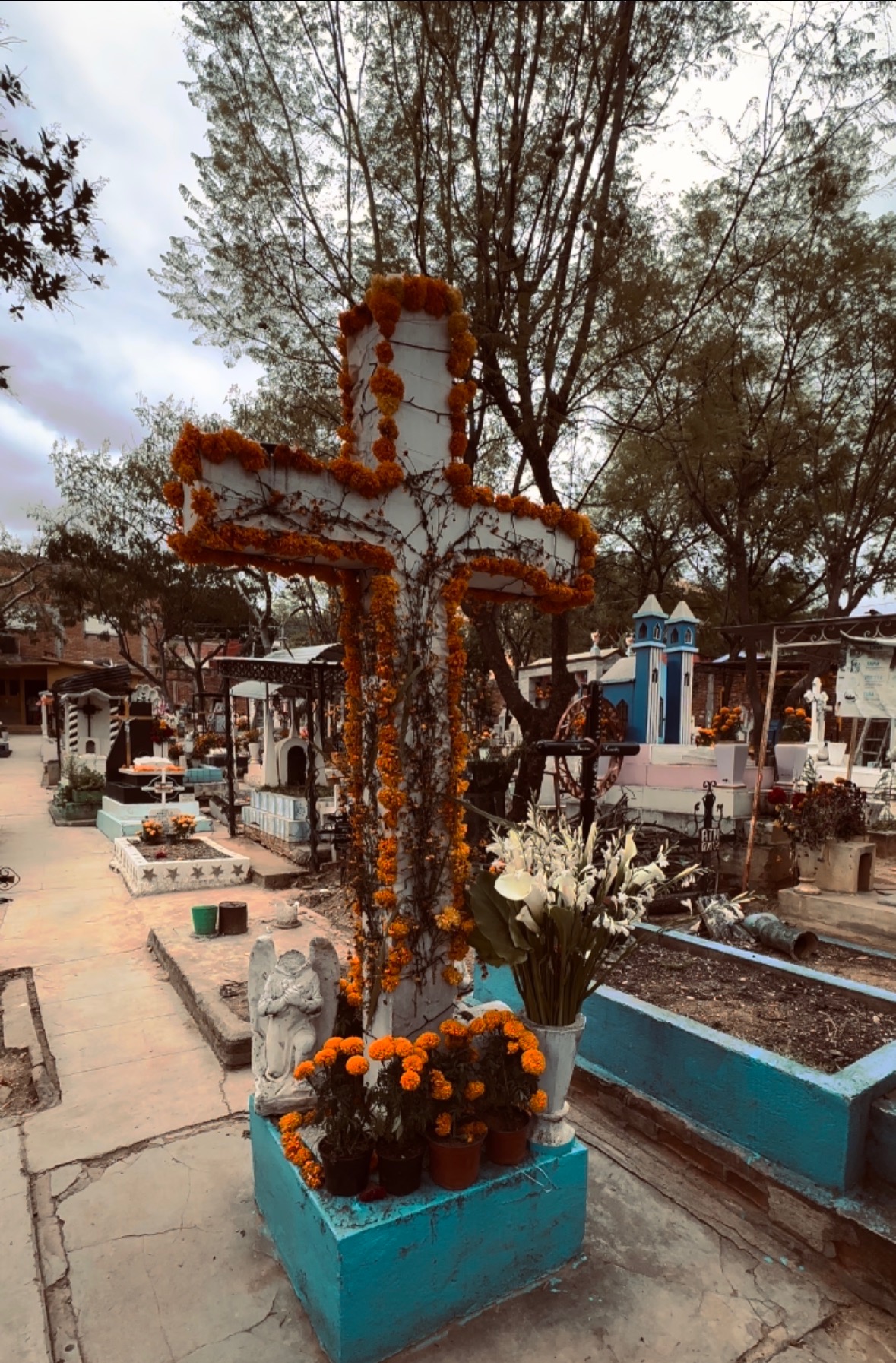
Part of the experience of Dia De Muertos is visiting a cemetery, but please when doing so, remember to be respectful and not interfere with the locals that are there to remember their loved ones! The following cemeteries are inside the city and they are easy to reach by walk if walking is your main mode of transportation:
- Panteón General:
- Location: Situated to the northeast of the historic center, Panteón General is one of the oldest cemeteries in Oaxaca City.
- Atmosphere: During Dia de Muertos, this cemetery comes alive with a vibrant display of color and tradition. The air is filled with the scent of marigold flowers, incense, and the warmth of candlelight.
- Altars and Graves: Families create elaborate altars at the gravesites of their loved ones, adorned with photographs, favorite foods, drinks, and other personal items. The atmosphere is one of reverence and celebration.
- Artistic Gravesites: Panteón General is known for its artistic gravesites and mausoleums, showcasing a variety of architectural styles and designs.
- Community Gatherings: It’s a gathering place for both locals and visitors, fostering a sense of community as people come together to honor and remember their departed loved ones.
- Panteón Xochimilco:
- Location: Situated southwest of the historic center, Panteón Xochimilco offers a unique and atmospheric experience.
- Setting: The cemetery is characterised by narrow pathways lined with tombs and graves, creating an intimate and somewhat maze-like environment.
- Community Participation: Families engage in a communal effort to clean and decorate the gravesites, and the atmosphere is filled with a mix of solemnity and festivity.
- Artistic Displays: Panteón Xochimilco is known for its artistic displays, including intricate sand tapestries called “alfombras,” created directly on the ground, often depicting intricate and symbolic designs.
- Local Traditions: This cemetery is known for preserving and showcasing local traditions, providing visitors with a genuine and culturally rich experience during Dia de Muertos.
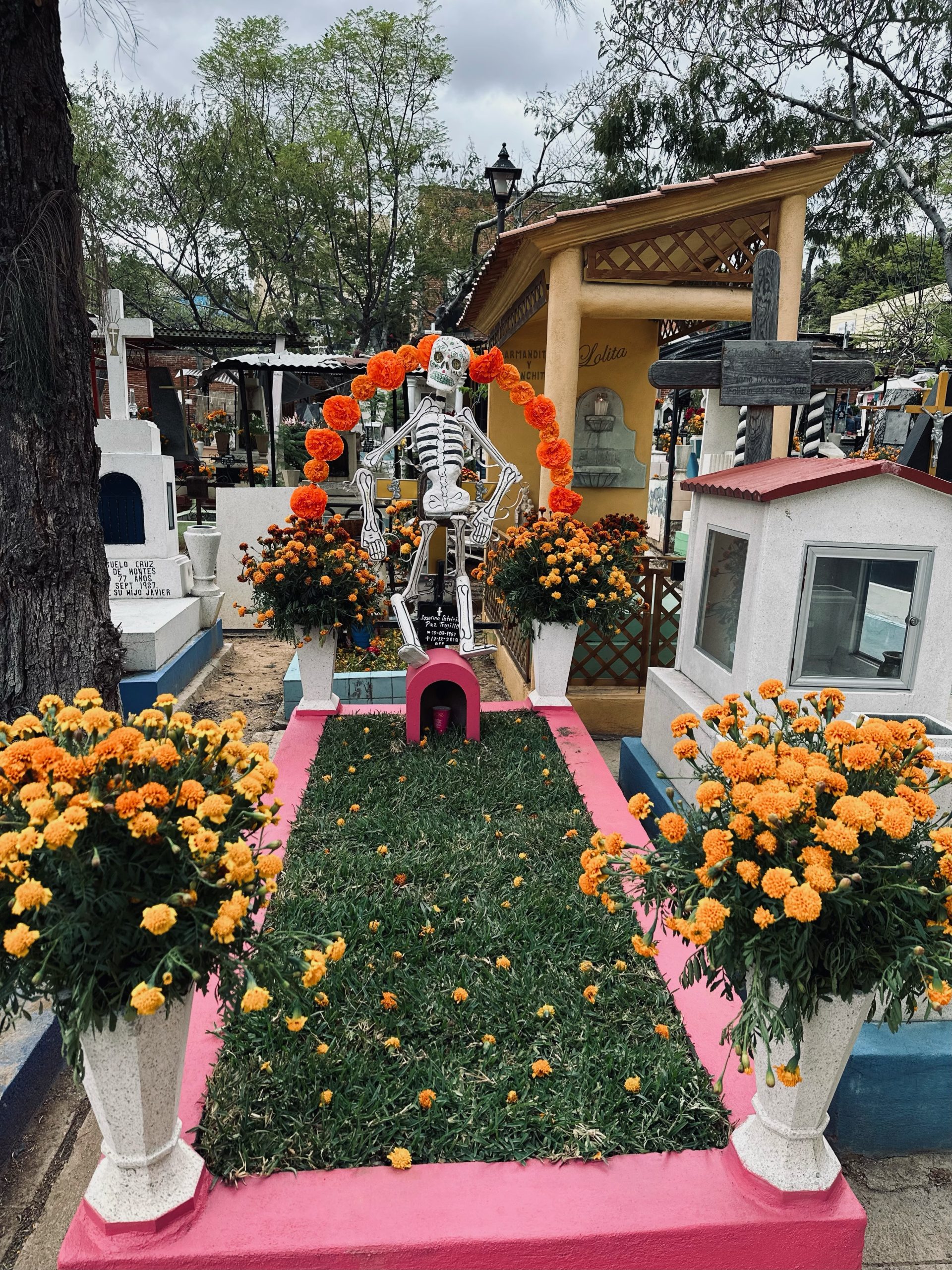
Both Panteón General and Panteón Xochimilco offer unique insights into the way Dia de Muertos is celebrated in Oaxaca, providing a meaningful and visually stunning experience for those seeking to immerse themselves in this deeply rooted tradition.
If you are willing to rent a car or pay a taxi to go a little bit outside the city alternatively you could go to visit these cemeteries, you are going to have a real authentic experience: Mitla Cemetery (Panteón de San Pablo Villa de Mitla), San Felipe del Agua Cemetery (Panteón de San Felipe del Agua), Xoxocotlán Cemetery (Panteón de San Sebastián Xoxocotlán).
Tips To Experience Dia De Muertos (Responsibly):
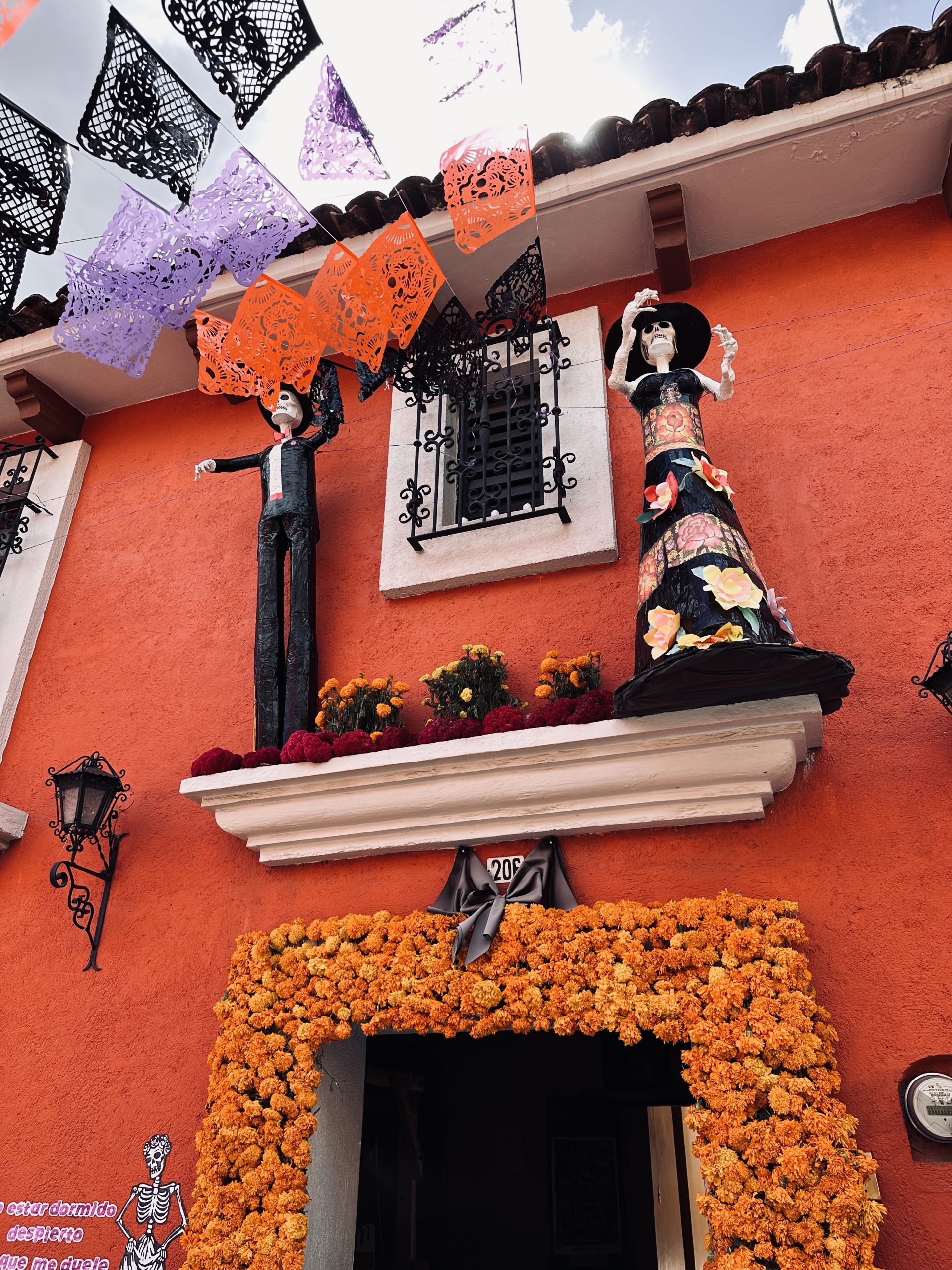
- Plan your trip way in advance, I booked everything 8/9 months before the actual date: this is one of the biggest event for the city of Oaxaca so if you want to have a good experience, you need time to plan.
- When visiting the cemetery please do not go with your face painted. Remember, Dia de Muertos is not Halloween. People are there to remember their beloved ones, so be respectful and avoid to go there dressed up and with your face painted.
- While it is custom for locals to drink mezcal on the grave of their loved ones, doesn’t mean you are allowed to do the same. I saw many tourists getting drunk at the cemetery being completely disrespectful and they had to be sent away, so please mindful of that.
- As you can imagine, it is a very personal and intimate moment to celebrate, if you want to take pictures of the people always ask for permission first.
- As first timers, I’d suggest to select your accommodation in the following areas: Centro Historico, Zocalo, Santo Domingo, Barrio de Jalatlaco.
- Arrive early: possibly 30th or 31st of October, to fully immerse yourself in the festive atmosphere!
- Don’t treat this experience as a tourist attraction. The Day of the Dead is a centuries-old cultural tradition, so have fun, but approach it with respect and cultural sensitivity. Embrace the experience as an opportunity to connect with the rich heritage and traditions of the local community rather than just a spectacle for visitors.
